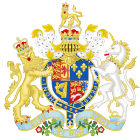Bank Restriction Act 1797 facts for kids
| Act of Parliament | |

|
|
| Long title | An Act for confirming and continuing for a limited time, the restriction contained in the minute of council of the twenty-fifth of February one thousand seven hundred and ninety-seven, on payments of cash by the bank. |
|---|---|
| Citation | 37 Geo. 3. c. 45 |
Quick facts for kids Dates |
|
| Royal assent | 3 May 1797 |
| Expired | 2 December 1797 |
| Other legislation | |
| Repealed by | Statute Law Revision Act 1871 |
|
Status: Repealed
|
|
| Act of Parliament | |

|
|
| Long title | An Act to amend and continue, until one month after the conclusion of the present war, the provisions contained in an act, passed in the session of parliament of the thirty-sixth and thirty-seventh years of his present Majesty, chapter ninety-one, videlicet, on the twenty second of June one thousand seven hundred and ninety-seven, for the restriction on payments of cash by the bank. |
|---|---|
| Citation | 38 Geo. 3. c. 1 |
| Dates | |
| Royal assent | 30 November 1797 |
| Text of statute as originally enacted | |
The Bank Restriction Act 1797 was a special law passed by the Parliament of Great Britain. This law stopped the Bank of England from having to exchange its paper money (banknotes) for gold. This change lasted for many years, from 1797 until 1821. This time is often called the Restriction period.
Contents
Why Was the Bank Restriction Act Needed?
People Wanted Gold Instead of Paper Money
Before this law, people could take their paper banknotes to the Bank of England and swap them for real gold. But more and more people started doing this. The Bank of England was quickly losing its supply of gold.
The Gold Standard and Banknotes
At the time, Britain used something called the gold standard. This meant that the value of paper money was directly linked to how much gold the country had. If the Bank printed too many banknotes without enough gold to back them up, each banknote became worth less.
Fear of a Bank Run
For a few months, banks in places like Newcastle-upon-Tyne and Durham had problems. Many people tried to take out their money at once, which is called a "run on the bank." These local banks asked the Bank of England for help.
Then, in February 1797, French forces tried to invade Britain at Fishguard. When people in London heard this news, they worried that everyone would rush to the Bank of England to get their gold.
Protecting the Bank's Gold
The Bank of England had about £10.8 million in banknotes in circulation. But it only had about £5.3 million in gold. If everyone tried to get their gold, the Bank would run out and go bankrupt. So, Parliament decided to stop these "specie payments" (payments in gold) right away. This suspension was renewed every year until 1821.
Why Were So Many Banknotes Printed?
Funding the War with France
The British government, led by William Pitt the Younger, started printing many more banknotes after Britain declared war on revolutionary France in 1793. The Bank Restriction Act helped the government because it no longer had to worry about people demanding gold for all these new banknotes.
Changes After the War
By the end of the war in 1814, there were £28.4 million in banknotes circulating. But these were only backed by £2.2 million in gold. This was a big difference!
However, things changed by 1821. A politician named Sir Robert Peel (who later became Prime Minister) helped create new economic policies. By then, there were £2.2 million in notes, but they were backed by a huge £11.2 million in gold. Because of this, the British government was able to start exchanging banknotes for gold again on May 1, 1821. This was even two years earlier than planned!
See also
- Peel's Bill
- Inflation
- Depreciation

